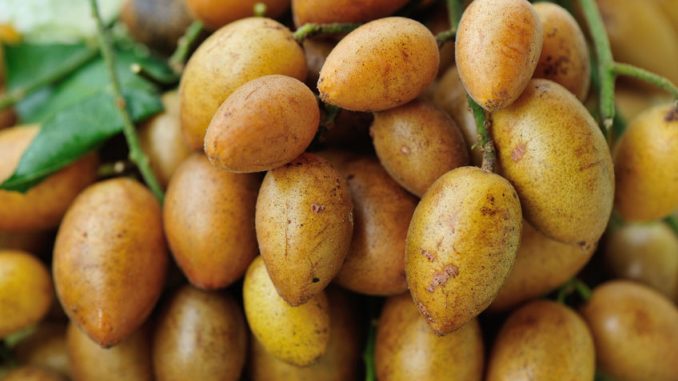
Wampee (Clausena lansium (Lour.) Skeels) is grown in many parts of China for its leaves. These are used as traditional medicines and food ingredients for treating respiratory conditions such as asthma and cough, for viral forms of hepatitis, dermatological and gastrointestinal diseases (Lim, 2012).
The plant is indigenous to Southern China. It is a member of the Rutaceae family.
The fruit is also harvested and is grown as well in a number of South-Eastern counties including Cambodia, Indonesia, Laos, Malaysia, the Philippines, Singapore, Vietnam and Thailand. You see some fruit grown in India, Sri Lanka, Australia (north Queensland, Northern Territory), the United States (Hawaii and Florida) and in Central America.
The fruit resembles grapes in appearance. It has an acidic taste and can be eaten along with the peel. The fruits are usually eaten fresh or served with meat dishes. Some fruit is converted to jams, preserves and in some rare cases chutney.
Components In Wampee
The leaves contain clausenamide (Li et al., 1996), carbazole alkaloids (Lakshmi et al., 1998) and essential oils (Pino et al., 2006). In the leaf oils, 70 compounds are reported and the major constituents were caryophyllene oxide (16.8%) and (Z)-α-santalol (11.7%).
Medical Uses And Benefits
The bioactive compounds from leaf extracts are able to improve and enhance memory and to treat Parkinson’s and Alzheimer’s diseases (Hu et al., 2010). This study is based however on investigations in cell lines but there is a case to be made for continued investigation.
References
Hu, J.‐F., Chu, S.‐F., Ning, N. et al. (2010). Protective effect of (−)clausenamide against Aβ‐induced neurotoxicity in differentiated PC12 cells. Neuroscience Letters, 483, pp. 78–82. https://doi.org/10.1016/j.neulet.2010.07.067
Lakshmi, V., Raj, K. & Kapil, R.S. (1998). Chemical constituents of Clausena lansium: part III ‐ Structure of lansamide‐3 and 4. Indian Journal of Chemistry, 37, pp. 422–424.
Li, S.H., Wu, S.L. & Li, W.S. (1996). Amides and coumarin from the leaves of Clausena lansium. Journal of Chinese Pharmaceutical Sciences, 48, pp. 367–373.
Lim, T.K. (2012). Clausena lansium. In: Edible Medicinal And Non‐ Medicinal Plants. (edited by T.K. Lim) Pp. 871–883 Dordrecht, Netherlands: Springer.
Pino, J. & Marbot, R., Fuentes, V. (2006). Aromatic Plants from Western Cuba IV. Composition of the Leaf Oils of Clausena lansium (Lour.) Skeels and Swinglea glutinosa (Blanco) Merr. Journal of Essential Oil Research, 18, pp. 139–141 https://doi.org/10.1080/10412905.2006.9699044
Prasad, K.N., Jing, H., Yi, C. et al. (2009). Antioxidant and anticancer activities of wampee (Clausena lansium (Lour.) Skeels) peel. Journal of Biomedicine & Biotechnology, 2009, pp. 612805–612810 http://dx.doi.org/10.1155/2009/612805
Leave a Reply